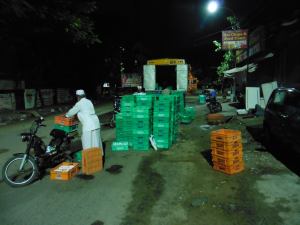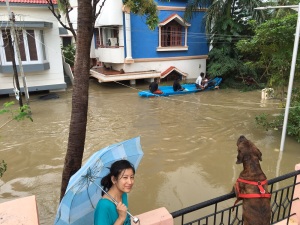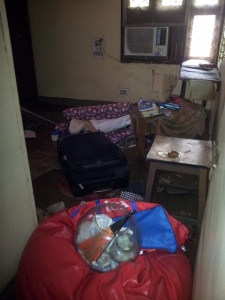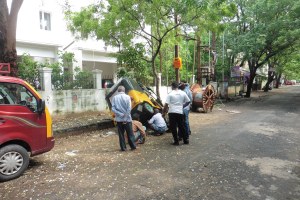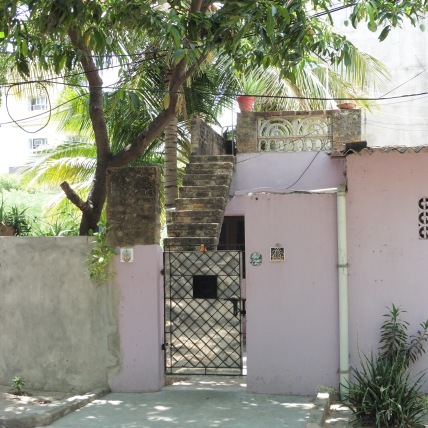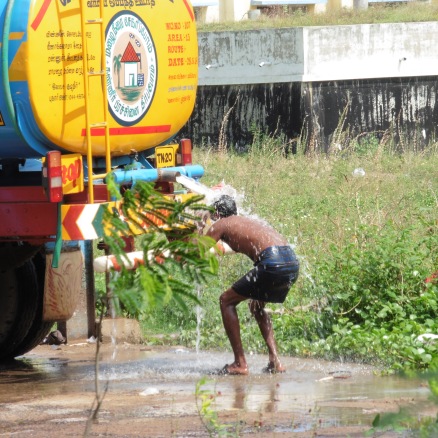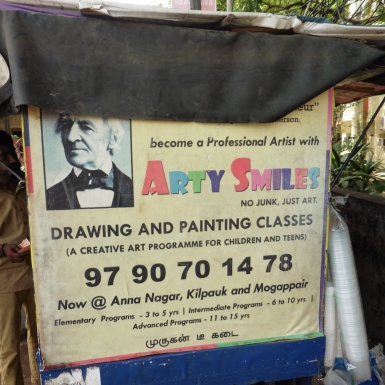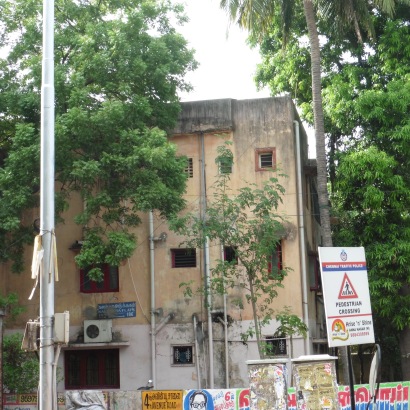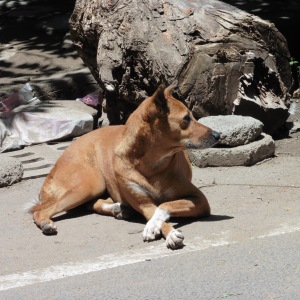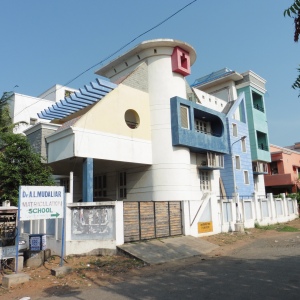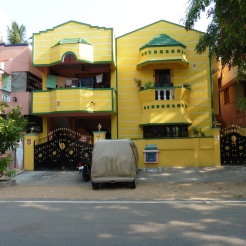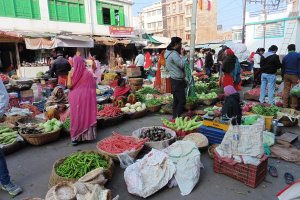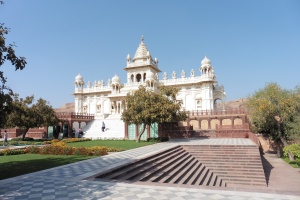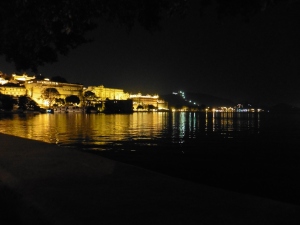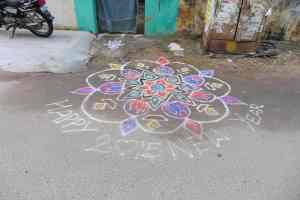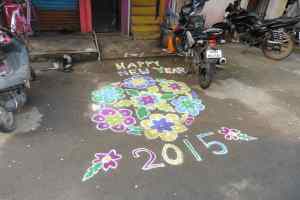Contemplating the Buddha

Last month I spent a week riding a bicycle in Sri Lanka. It was an organized tour that took a small group to five of Sri Lanka’s UNESCO World Heritage sites. If that sounds a bit academic and dry, I assure you it wasn’t. All our hotels were five-star, each with a pool and bar. Following a day’s ride and quick dip, we convened at the bar and proceeded to mix Elephant House Ginger Beer with Lion lager to make a shandy (or radler—Bavarian for cyclist). Delicious, refreshing and wet.


The official name of the country is the Democratic Socialist Republic of Sri Lanka, and despite this anachronistic moniker, it is a presidential parliamentary democracy. Sinhala translates to “lion people” and refers to the myths regarding the descent of the legendary founder of the Sinhalese people, the Prince Vijaya. The former names of the country “Serendib”, “Seylan” and “Ceylon” all derived from the old name “Sinhale”.
The island was ceded to the British in 1796, became a crown colony in 1802, and was formally united under British rule in 1815. As Ceylon, it became independent in 1948, and its name was changed to Sri Lanka in 1972. The name means ‘resplendent island’ in Sinhalese.
Tensions between the Sinhalese majority and Tamil separatists erupted into war in 1983, and it was 26 years before the Sri Lankan government could announce that its military had defeated the remnants of the Liberation Tigers of Tamil Eelam. An estimated 100,000 people died in the carnage. In February of this year, following an intense lobbying campaign by the country’s newly elected government, the United Nations Human Rights Council agreed to defer until September the release of a landmark inquiry into possible war crimes.
The area of the country is 65.5 thousand sq. km, which is slightly larger than West Virginia, and a bit smaller than Ireland. You could fit 14 Sri Lanka’s into the land area of British Columbia, although the Sri Lanakans wouldn’t like the climate.

The population of almost 22 million Sri Lankans is 75% ethnic Sinhalese, with Tamils and Moors making up the rest. The first Sinhalese arrived in Sri Lanka in the 6th century B.C.E., probably from northern India. Modern genetic investigations suggest that the Sinhalese are most closely related to the Bengali people.
The Sinhalese are predominantly Theravada Buddhists, although a small percentage follow branches of Christianity. Theravada, the oldest Buddhist school, is practiced mostly in Sri Lanka, Cambodia, Laos, Burma, and Thailand. Sri Lanka has the longest continuous history of Buddhism of any Buddhist nation, and there are some 6,000 Buddhist monasteries and more than 15,000 monks in the country.

Our bike tour took us to the following important Buddhist sites:
Sacred City of Kandy
Golden Temple of Dambulla
Ancient City of Sigiriya
Ancient City of Polonnaruwa
Sacred City of Anuradhapura
On our first day we rode from the airport city of Negombo, northward along the coast and then inland to the Sacred City of Kandy. Founded in the 14th century, Kandy was the last capital of the Sinhala kings, whose patronage enabled the Dinahala culture to flourish for more than 2,500 years until the occupation of Sri Lanka by the British in 1815. The city, along with Polonnaruwa and Anuradhapura, and the interior sites at Dambulla and Sigiriya, comprise Sri Lanka’s ‘Cultural Triangle’.


Temple Interior
Kandy is the site of the Temple of the Tooth (Daladha Maligala), one of the most sacred Buddhist pilgrimage destinations. The Buddha’s left upper canine tooth–there was remarkably good record keeping back then–was reputedly stolen from the flames of his funeral pyre in 543 B.C.E.
For 800 years, the Tooth was kept at Dantapura in the State of Orissa (now Odisha), India, and smuggled into Sri Lanka during the 4th century C.E. This tooth relic is allegedly enshrined in the Temple of the Tooth.

Worshipping Tooth Relic Casket
I am providing some advice to pilgrims visiting the Tooth relic. The refreshingly candid notes on crowd control are consistent with my experience at most temples in India. Also note the reference to the civil war.
At the entrance, which consists of a bridge over the moat, is a large Kandyan style moonstone and on either side of the stairs are two stones carvings of elephants with their drivers. All this is recent, the originals having been completely destroyed in a terrorist bomb attack of 1998.
The Tooth itself is rarely displayed. If you wish to worship the Tooth close up it will be necessary to come at about 5 p.m. on any evening and stand in line. When the doors open you will pass quickly through two small rooms to the third room where the Tooth is kept. It is not usually possible to notice much, as the crowds are large and the attendants keep everyone moving. In a minute, you will be standing before the large golden stupa that enshrines the Tooth, and a minute later you will be out the side door.
The following day we headed north to Dambulla, where a few kilometres south is a Buddhist cave-temple complex established in the 3rd century B.C.E. The site has been in continuous use for over 22 centuries, starting when it was occupied by a Buddhist monastic establishment following the arrival of Buddhism on the island.
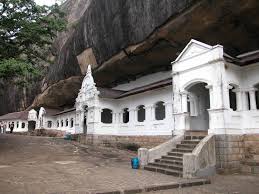
Exterior of Golden Temple Caves
In the 12th century, King Nissankamalla had the lying, sitting and standing Buddha images in the largest cave gilded, naming it ‘Golden Rock Cave’. It was subsequently enlarged and five temples constructed. It is now known as the Golden Temple (referring to the entire complex) and is a sacred pilgrimage site.


The cave monastery, with its five sanctuaries, contains 157 statues and mural paintings covering an area of 2,100 sq. m. Most of the paintings were done in the 18th and early 19th century, while a few were painted in the early 20th century. The excavated shrine-caves, their painted surfaces, and statuary are considered unique in scale and degree of preservation.


Our next stop was the Ancient City of Sigiriya. It is an important archaeological site dominated by a massive rock nearly 200 metres high. As usual, the area was first a Buddhist monastic settlement dating to the 3rd century. Sigiriya was a Mahayana monastery and meant to suggest Mount Potala or an imitation of it. One ancient text calls the place the Lion Mountain (Sihagiri) but the earlier and probably original name was the Mountain of Remembrance (Sihigiri).

The top of the rock (the Lion Rock) has the ruins of an ancient citadel and palace built by King Kashyapa during the 5th century. He founded his capital here, but ruled for only eleven years. When this unsavory king left, Buddhist monastics settled in the area until about the 13th or 14th century.


Halfway up are rock paintings—The Maidens of the Clouds. The paintings have a close resemblance to paintings seen in the Ajanta caves in India. It is suggested that they represent Tara, the consort of Avalokitesvara, and her attendants. Tradition says that Avalokitesvara has 108 names, one of which is Natha and it is under this name that the bodhisattva is still worshipped in Sri Lanka.

For me the site had double significance. The site is considered one of the best preserved examples of ancient urban planning—very elaborate and imaginative—and it has one of the oldest landscaped gardens in the world, including water gardens, cave and boulder gardens, and terraced gardens.
The plan combined concepts of symmetry and asymmetry to intentionally interlock the man-made geometrical and natural forms of the surroundings. On the west side of the rock lies a park for the royals, laid out on a symmetrical plan; the park contains water-retaining structures, including sophisticated surface/subsurface hydraulic systems, some of which are working today. The moats and walls that surround the lower palace are exquisitely beautiful.
The next stop on the tour was Polonnaruwa, the second capital of Sri Lanka after the destruction of Anuradhapura in 993. The city reflects several civilizations, notably that of the conquering Cholas, disciples of Brahminism, and that of the Sinhalese sovereigns during the 12th and 13th centuries.

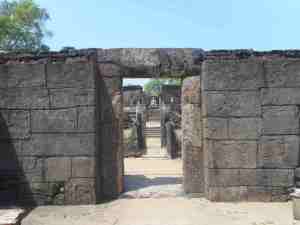
Polonnaruwa, like Sigiriya, also held special interest for me, comprising as it does the monuments built by the Cholas, and the extensive ruins of the remarkable garden-city created by Parakramabahu in the 12th century. The site is regarded as one of history’s most astonishing urban creations, both because of its unusual dimensions, and because of the very special relationship of its buildings with the setting and environment. It goes without saying that it is a shrine of Buddhism and of Sinhalese history.



Our last stop was the sacred city of Anuradhapura, established around a cutting from the ‘tree of enlightenment’, the Buddha’s fig tree, brought from Inida in the 3rd century B.C.E. by Sanghamitta, the founder of an order of Buddhist nuns. The Bodhi tree flourished and now spreads from a sanctuary near the Brazen Palace. The city was a political and religious capital that thrived for 1,300 years, but was abandoned after an invasion in 993. Hidden in dense jungle for many years, the impressive site, with its palaces, monasteries and monuments, is accessible once again.

Bodhi Tree
The city is one of the main shrines of Buddhism and holds many temples and stupa (literally “heap,”) a mound-like, hemispherical structure containing relics and used as a place of meditation.
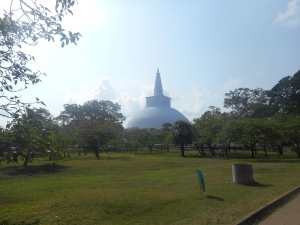

Professor Robert Thurman, Uma’s dad, and co-founder with Richard Gere and Philip Glass of Tibet House U.S., elaborates on the definition:
Stupas… demonstrate the triumph of enlightenment’s wisdom over suffering’s ignorance. They are memorials… to the possibility of freedom from suffering for all beings. They signal the triumphal reality of a nature that enables beings to evolve to experience the ultimate fulfilment of perfect bliss, beyond death and unsatisfying life. Stupas stand as eloquent testimony to the higher purpose of life, beyond competing or struggling, getting or spending. Consciously or subliminally, they help turn people’s minds away from their frustrating obsessions and towards their own higher potential.
(From the foreword to Buddhist Stupas in Asia: the Shape of Perfection).
I vote we replace the ooky pyramid on the U.S. dollar bill with a stupa.
Mahachatiya, the Great Stupa in Anuradhapura is apparently the largest ever built, with a diameter of 294 feet at the base and a height of 300 feet. We just happened to be on-site when the new “robe” was carried to the stupa for ceremonial wrapping. Lay Buddhists were actively involved.

Lay Buddhists carrying the 294 foot “robe” for the stupa.
Reflections
One startling revelation for me on this bike tour of Sri Lanka was Buddhism as a lived religion. Almost everyone I met was a Buddhist, including our riding guide and van driver, bartenders, hotel staff, street sweepers, and so on.
Growing up in Vancouver I had scant exposure to Buddhism. Of course, in the ’60s I was aware of self-immolating monks in Vietnam, and I was an avid reader of the Beat authors Jack Kerouac (Dharma Bums) and Gary Snyder (a poet and Buddhist scholar). I also read Alan Watts (The Way of Zen) and Shunryu Suzuki (Zen Mind, Beginner’s Mind).
In 1980, my curiosity brought me to a lecture by the Dalai Lama, and a few years later, in a small church on the edge of Vancouver’s West End, I was awestruck by the chanting of Gyuto monks and the sound of their dungchen (Tibetan long trumpets).
Later still, at the Victoria Art Gallery I was transfixed by the 5-day creation of a sand mandala by monks, which when finished, was tossed into the ocean to symbolize the transitory nature of material life. And more recently, I visited the Deer Park Monastery near San Diego, a mindfulness practice center founded by the Vietnamese Buddhist monk Thich Nhat Hanh. I had a nice lunch.
But among my friends there were no Buddhists and I wasn’t sufficiently motivated to become a practitioner. So I arrived in Sri Lanka burdened with several misconceptions that I suspect might be typical among Westerners: that Buddhism is a philosophy, not a religion; that Buddhism is all about enlightenment and not day-to-day life; and, that the sophisticated meditative practices and philosophical insights found in the ancient texts provide a model for all Buddhists to follow.
As a corrective to my woeful ignorance, and to expand my knowledge of the variety of ways there are to “be” Buddhist, I undertook a bit of remedial study. One source summed it up nicely:
All religion must deal with people’s actual daily needs, and the needs of Buddhists do not differ from those of others: to be materially comfortable, to be healthy, to be surrounded by family and friends, to live a long life after which one goes to heaven.
OK, gotcha. Heaven here we come!
Several schools and sects of Buddhism exist, differing often on the nature of the Buddha, the extent to which enlightenment can be achieved—for one or for all, and by whom—religious orders or laity. I discovered that the basis of Buddhist life is morality; that until the modern period very few monks practiced meditation; that wisdom is progressive with meditation; and only when wisdom is perfected does enlightenment result.
Most Buddhists—past and present—have focused on the development of a sound moral foundation, one that may take numerous lifetimes to establish. Some texts are designed for those who are at the foundational stage (morality), others for those who have progressed beyond that (meditation).
In Buddhism, one achieves a moral foundation through the accumulation of merit. The merit is acquired by individuals and brings pragmatic and religious benefit to them, but it also benefits society through the redistribution of wealth and merit to family and friends, transfer of merit and rituals performed, and donations to religious specialists. This is the religious path followed by most Buddhists.
A historically and sociologically informed overview of how Buddhism is lived in individual lives falls into four interlocking tracks of legitimate Buddhist striving: 1) pragmatic wellbeing, via rituals and merit-making; 2) moral cultivation, via donations, pure conduct, and compassionate acts; 3) better rebirth (human or in a heaven), via merit-making and merit transfer; 4) seeking nirvana, via meditation.
That seems clear enough.
So against this background, what in Buddha’s name is going on in Myanmar?
The answer to that question is my second revelation arising from a pleasant holiday trip in Sri Lanka— Buddhism is being corrupted. Buddhist fundamentalism is spreading in Sri Lanka, Myanmar and Thailand, and the media increasingly report violent attacks on religious minorities–mostly Muslims.
In Sri Lanka, the resurgence of Sinhala-Buddhist nationalism began after the end of the final phase of the military’s war against Tamil Tigers in 2009, which had resulted in the death of tens of thousands of civilians. The military victory led to contemplation on the nation’s identity, allowing the regime to promote ethno-religious nationalism to gain legitimacy for actions that were otherwise contrary to democracy and international law. (See note above about UN report on war crimes.) The war was portrayed as a struggle against Tamil nationalism and the victory as a triumph for Buddhism.
Ashin Wirathu is an ultranationalist Buddhist monk, and the spiritual leader of the anti-Muslim movement in Myanmar. He is a textbook demagogue, and describes himself as the “bin Laden” of Buddhism. Time Magazine put his picture on their cover in 2013.

For almost three decades, Wirathu has espoused his belief that the Muslims have a “master plan” to convert the predominantly Buddhist Myanmar to Islam. He has been held responsible by critics and human rights groups for the Rohingya boat people crisis.
The Rohingya are one of the world’s most persecuted minorities. They are mostly Muslims living in Myanmar and other parts of South Asia and Southeast Asia, but the Myanmar government refuses to recognize them as citizens. Many are denied basic rights and access to welfare services. There are an estimated 1.3 million Rohingyas living in the country’s Rakhine State.
In 2012, Wirathu led a rally of monks to promote President Thein Sein’s controversial plan to send Rohingya Muslims to a third country. According to the Myanmar authorities, the violence, between ethnic Rakhine Buddhists and Rohingya Muslims, left 78 people dead, 87 injured, and up to 140,000 people displaced. A number of monks’ organisations have also taken measures to boycott NGOs which they believe helped only Rohingyas in the past decades.
In 2015, to escape systemic violence and persecution from the Myanmar government, thousands of Rohingyas migrated from the country. Collectively dubbed as ‘boat people’ by international media they sailed to Southeast Asian countries including Malaysia, Indonesia and Thailand in rickety boats. The United Nations High Commissioner for Refugees estimates about 25,000 people have taken to boats from January to March 2015. The exodus of the Rohingyas from Myanmar in crowded fishing boats is the latest in the chapter of the brutal history of a community victimized by the government of the country they lived in for generations.
It goes without saying that the portrayal of a threat to the majority religion and the linking of Buddhism to the national identity, are both against true Buddhist principles. Yet Buddhist extremist groups are now seeking to form an international alliance of “likeminded” organizations to address their “concerns,” such as blasphemy against Buddhism. Does the project sound familiar?
These unprecedented developments raise many concerns, not least among them continuing attacks on Muslim minorities, threats to international security and tarnishing of the reputation of Buddhism as a religion of peace.
The turning away of refugees in boats in Southeast Asia and Europe is one of the more unfortunate patterns of nations. Forget the language of “we’re in a global boat together”, when faced with immigrants fleeing persecution, economic devastation, and hunger, there are many reasons to say no. We forget the disgraceful episodes in the past, whether the Komagata Maru in 1914 or the MS St. Louis in 1939 (The Voyage of the Damned), and now countries in Europe denying entry to the Mediterranean boat people.
We have conveniently forgotten a shameful discussion at the Hotel Royal in Évian les Bains on Lake Geneva in July, 1938. It was there that 31 nations met to discuss the plight of the Jews of Germany and Austria, and although many delegations voiced ‘eloquent dismay’ over the torment experienced by the Jews, those sentiments were rhetorical only. The outcome of the meeting was a polite but blank denial of reality. Neither Europe, nor the United States, nor Canada nor Australia would accept the refugees in any meaningful number.
Today, many countries are in what Zeid Ra’ad Al Hussein, UN High Commissioner for Human Rights, calls moral default.
Must we not ask ourselves, therefore, what will be our future, if we succumb to a thinness of mind, to a fanatic populism, where our fears are so easily stirred, our reasoning so easily subdued? If all states, in due course, mimic the most anti-immigrant of countries, and garrison their foreign policy with barbed wire, machinegun nests, and naval vessels; impenetrable to the suffering of the wretched who flee war and persecution—what will be our common destination then? To what address will humanity go?
The power to choose between good and evil is within reach for all of us, as Origen says. Moral blankness—an indifference to the fate of others—is a choice. We may understand it, but we must resist it. When people retract into blankness about the fate of others, this may stem from fear. It may be a partial blankness—”our” group is important, “their” group is not fully equal, fully deserving of human rights. The need for the sense of belonging—we matter, but they do not—is a powerful tug. But the path of moral blankness and discrimination leads to hatred, and to the world of war. Unchecked, it threatens us all.
Buddhist fundamentalists and rabid nationalists have chosen moral blankness, a very surprising revelation for me. They make no merit, they renounce moral cultivation and any hope of a better rebirth, and they have abandoned the path to nirvana. What a bizarre turn of events and what a wretched shame.






























